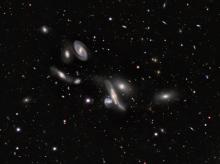Listen to today's episode of StarDate on the web the same day it airs in high-quality streaming audio without any extra ads or announcements. Choose a $8 one-month pass, or listen every day for a year for just $30.
You are here
G Stars
Under a dark sky, far from city lights, the eye alone can see thousands of stars. They come in a variety of brightnesses and colors. Yet only a few of those pinpoints of light are like the Sun.
Stars are classified based on their surface temperature, which is an indication of their color. Hot stars are blue and white, while cool stars are orange and red. The Sun is in the middle, shining yellow-white, with a surface temperature of about 10,000 degrees Fahrenheit. Those traits mean it’s a member of class G.
From hottest to coolest, stars are classified with the letters O, B, A, F, G, K, M. Each class is broken up into 10 sub-categories. And each star is given a Roman numeral that indicates its size and its stage in life.
The Sun is class G2V. That means it’s toward the hot end of class G, and that it’s on the “main sequence” — it’s in the prime of life, converting the hydrogen in its core to helium.
A couple of moderately bright G main-sequence stars are in view by about 10 p.m. 51 Pegasi is in the south, almost directly above the Moon. At the same time, Tau Ceti is low in the southeast.
The brightest class G main-sequence star visible from Earth is Alpha Centauri A. It’s the leading light of a triple star system that’s about four light-years away — closer than any other stars. It’s so far south, though, that it’s visible from only a tiny sliver of the United States.
More about G stars tomorrow.
Script by Damond Benningfield





